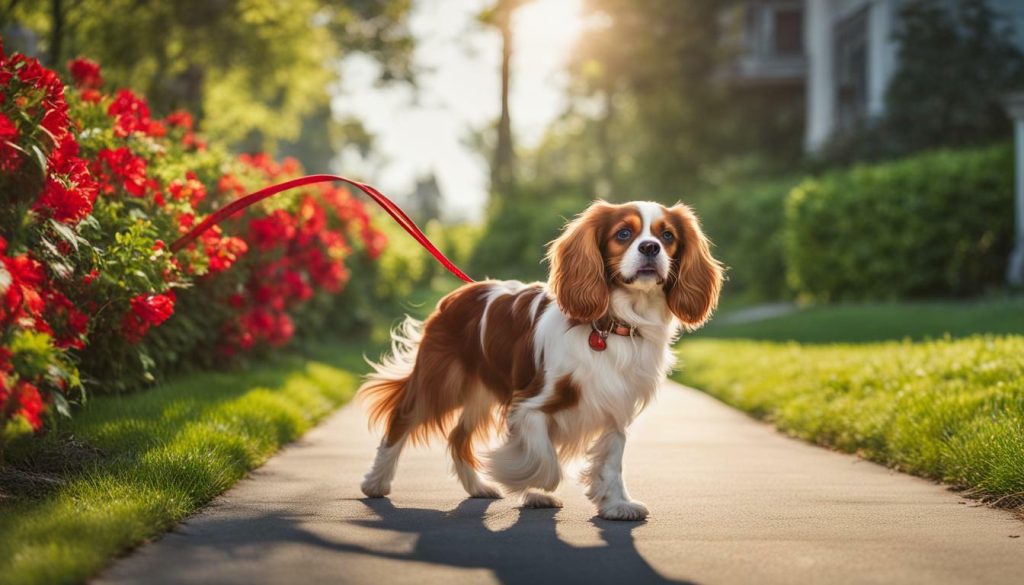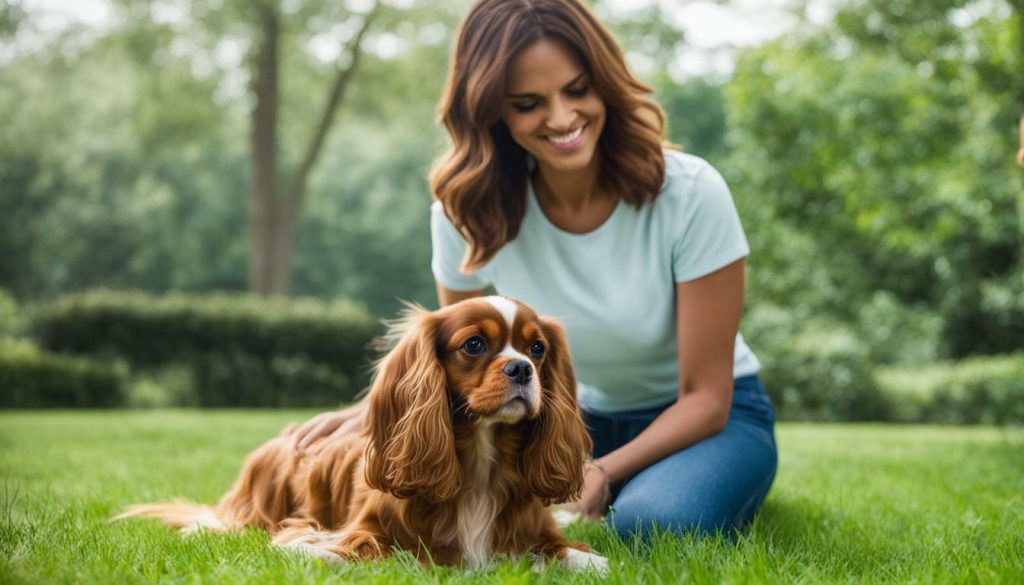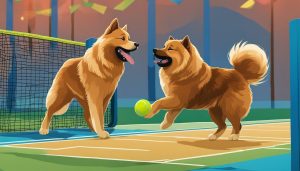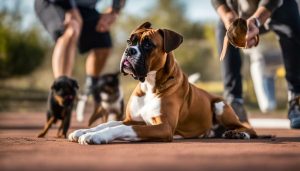Training a Cavalier King Charles Spaniel requires consistency, patience, and a nurturing approach to develop a loving and obedient pet. This breed is known for its affectionate nature and eagerness to please, making them highly trainable companions. To ensure successful training, it is important to set specific goals at different milestones in your puppy’s development, starting with early socialization with the breeder.
During training, essential areas to focus on include leash training, potty training, grooming, and teaching basic obedience commands. Positive reinforcement techniques, such as using treats and praise, greatly assist in motivating and encouraging desired behaviors. Short and frequent training sessions are recommended to keep your Cavalier King Charles Spaniel engaged and energetic.
- Consistency, patience, and a nurturing approach are vital for training a Cavalier King Charles Spaniel.
- Early socialization with breeders and other animals is crucial for the development of a well-rounded pet.
- Leash training, potty training, grooming, and basic obedience commands are essential training areas.
- Positive reinforcement with treats and praise helps reinforce desired behaviors in your pet.
- Involving all family members in the training process creates consistency and teamwork.
By following these training essentials and incorporating professional tips into your training routine, you can cultivate a loving and obedient Cavalier King Charles Spaniel that brings joy and companionship to your life.
Understanding the Cavalier King Charles Spaniel Breed
Before diving into the training process, it is crucial to understand the characteristics of the Cavalier King Charles Spaniel breed, known for its affectionate nature and eagerness to please. These small, toy spaniels are the epitome of a companion dog, thriving on human interaction and forming strong bonds with their owners.
Cavalier King Charles Spaniels are highly intelligent, making them quick learners when it comes to training. However, their sensitive nature requires consistency and patience in the training process. Positive reinforcement techniques, such as treats and praise, work wonders with this breed, as they respond well to gentle guidance and encouragement.
When setting training goals, it is important to consider the milestones in the puppy’s development. Early socialization with the breeder sets a solid foundation for their future interactions and behavior. Introducing them to various environments, people, and other animals helps them become well-rounded and confident adult dogs.

Training should encompass various aspects, including leash training, potty training, grooming, and basic obedience commands. Short, frequent training sessions are key, as their attention span may be shorter compared to larger breeds. It is important to make the training sessions enjoyable and positive to maintain their enthusiasm and focus.
Involving all family members in the training process helps establish consistency and reinforces the bond between the dog and the entire household. By consistently applying the same training techniques and commands, the Cavalier King Charles Spaniel will be more receptive and responsive to everyone’s efforts.
Summary:
- The Cavalier King Charles Spaniel breed is known for its affectionate nature and eagerness to please.
- Consistency and patience are essential in training this breed, using positive reinforcement techniques.
- Early socialization is crucial for their development, setting the stage for well-rounded adult dogs.
- Training should include leash, potty, grooming, and basic obedience commands.
- Short, frequent training sessions are effective, and involving all family members ensures consistency.
| Training Aspect | Key Points |
|---|---|
| Leash Training | Use positive reinforcement, start with short walks, gradually increase duration and distance. |
| Potty Training | Establish a consistent routine, reward desired behavior, and be patient during the process. |
| Grooming | Introduce grooming gradually, use positive reinforcement, and make it a positive experience. |
| Basic Obedience Commands | Focus on commands like sit, stay, come, and down. Use positive reinforcement and short, frequent training sessions. |
Socialization and Early Training
Socialization and early training play a vital role in shaping a well-behaved and adaptable Cavalier King Charles Spaniel dog. As a breed known for their affectionate nature and eagerness to please, it is crucial to start training your puppy at a young age to ensure they develop into obedient and well-adjusted companions. Here is a step-by-step guide to help you get started on training your Cavalier King Charles Spaniel dog.
- Start with socialization: Begin socializing your puppy with people and other animals as early as possible. Introduce them to different environments, sounds, and experiences to build their confidence and help them become comfortable in various situations.
- Establish a routine: Create a consistent daily routine for your Cavalier King Charles Spaniel, including regular feeding, exercise, and potty breaks. This will help them understand what is expected of them and promote good behavior.
- Teach basic commands: Start with simple commands such as “sit,” “stay,” and “come.” Use positive reinforcement techniques like treats and praise to reward your puppy for obeying these commands. Keep training sessions short and frequent to maintain their interest and prevent them from getting bored.
- Focus on leash training: Leash training is crucial for the safety of your Cavalier King Charles Spaniel and to ensure they are well-behaved when walking outdoors. Introduce them to wearing a collar and leash gradually, and use positive reinforcement to encourage them to walk politely by your side.
Quote:
“Consistency and patience are key when training a Cavalier King Charles Spaniel. By starting early and being consistent with your training techniques, you can shape your dog into a well-behaved and obedient companion.”
Remember to always use positive reinforcement techniques, such as treats and praise, to motivate and encourage your Cavalier King Charles Spaniel during training. It is important to be patient and understanding, as each dog learns at their own pace. With consistent training and early socialization, your Cavalier King Charles Spaniel will become a loving and obedient companion.

| Training essentials for Cavalier King Charles Spaniel Dogs | Effective training methods for Cavalier King Charles Spaniel Dogs |
|---|---|
| Regular socialization with people and other animals | Use of positive reinforcement techniques |
| Establishing a consistent daily routine | Short and frequent training sessions |
| Teaching basic commands | Gradual introduction to leash training |
Leash Training and Basic Obedience Commands
Mastering leash training and basic obedience commands is crucial for a well-behaved Cavalier King Charles Spaniel, and I will guide you through the process. The key to successful leash training is consistency and patience. Start by introducing your puppy to the leash gradually, allowing them to get used to the sensation and weight. Use positive reinforcement, such as treats and praise, to reward them for walking calmly by your side.
When teaching basic obedience commands, remember that Cavaliers are eager to please. Begin with simple commands like “sit” and “stay” in a quiet, distraction-free environment. Use a firm yet gentle tone and hand signals to accompany your verbal commands. Be patient and repeat the commands until your dog understands and responds correctly.
Socialization is also important during leash training. Expose your Cavalier to various environments, people, and other animals to help them become well-adjusted and friendly. This will make walks more enjoyable and prevent behavior problems in the future. Remember to keep training sessions short and frequent to maintain your dog’s focus and attention.
Leash Training Tips:
- Start leash training early to establish good habits.
- Use a lightweight leash and comfortable collar or harness.
- Walk at a relaxed pace and encourage your dog to stay by your side.
- Reward good behavior with treats and praise.
Basic Obedience Commands:
| Command | Hand Signal |
|---|---|
| Sit | Raise your hand with an open palm facing up. |
| Stay | Extend your arm with the palm facing forward. |
| Come | Extend your arm with the palm facing you. |
By following these training techniques and incorporating positive reinforcement, you can effectively train your Cavalier King Charles Spaniel to become a well-behaved and obedient companion. Remember, consistency and patience are key, and the effort you put into training will be rewarded with a loving and loyal pet.

Proper potty training and grooming are essential aspects of training a Cavalier King Charles Spaniel, and I will explain the necessary steps to achieve success in these areas. The breed’s affectionate nature and eagerness to please make them quick learners, but consistency and patience are key.
Potty Training: Start by establishing a designated potty area and a consistent schedule for bathroom breaks. Take your Cavalier King Charles Spaniel outside frequently, especially after meals and naps, and reward them with praise or a treat when they eliminate in the correct spot. Avoid punishment or scolding for accidents, as it can lead to anxiety and confusion.
Grooming: Regular grooming is essential for maintaining the health and appearance of your Cavalier King Charles Spaniel. Brush their medium-length, silky coat at least once a week to prevent tangles and matting. Pay special attention to their ears, as they are prone to ear infections. Trim their nails regularly, and brush their teeth to prevent dental issues. Consider professional grooming for trimming their coat if you’re unsure or uncomfortable doing it yourself.
Remember, training should be a positive and enjoyable experience for both you and your Cavalier King Charles Spaniel. Use treats and praise to reinforce desired behaviors, and keep training sessions short and frequent to maintain their interest. Consistency is key, and involving all family members in the training process will help establish a unified approach. With time, effort, and commitment, your Cavalier King Charles Spaniel will become a well-behaved and loving companion.

Positive reinforcement is a powerful tool for training a Cavalier King Charles Spaniel, and I will share professional tips to help you harness its full potential. This training technique revolves around rewarding desired behaviors with treats, praise, and affection, reinforcing the idea that good behavior brings positive outcomes. By using positive reinforcement, you can establish a strong bond with your pet and create a positive learning environment.
When using positive reinforcement, it is essential to be consistent and timely with your rewards. Immediately praise and reward your Cavalier King Charles Spaniel when they exhibit the desired behavior, such as sitting on command or successfully completing a trick. This instant reinforcement will help them understand which behaviors are desirable and increase the likelihood of them repeating those actions in the future.
Additionally, be sure to keep training sessions short and frequent. Cavalier King Charles Spaniels have a limited attention span, especially when they are young, so it is important to keep training sessions engaging and enjoyable. Aim for multiple short sessions throughout the day, focusing on one or two specific commands or behaviors at a time. This approach will prevent your pet from becoming overwhelmed and ensure a more productive training experience.
| Professional Tips for Positive Reinforcement Training: |
|---|
| 1. Use high-value treats that your Cavalier King Charles Spaniel finds particularly enticing. This will increase their motivation to learn and perform desired behaviors. |
| 2. Vary the rewards to keep your pet engaged. Alternate between treats, verbal praise, and even petting to provide a well-rounded reinforcement experience. |
| 3. Be patient and persistent. Training takes time, and each dog learns at their own pace. Stay consistent, and celebrate even small victories along the way. |
Remember, positive reinforcement not only helps you train your Cavalier King Charles Spaniel but also fosters a loving and trusting relationship between you and your furry companion. By using these professional tips and techniques, you can effectively train your Cavalier King Charles Spaniel while enjoying the process together.

Consistency and frequency are key factors in successfully training a Cavalier King Charles Spaniel, and I will guide you on how to incorporate these principles into your training regimen. Training a Cavalier King Charles Spaniel requires dedication and commitment, but the results are well worth the effort.
When it comes to consistency, it’s important to establish a routine and stick to it. Set specific training times each day and ensure that everyone in the household follows the same rules and commands. This will help your Cavalier King Charles Spaniel understand what is expected of them and make the training process more effective.
In addition to consistency, frequency is also crucial. Short, frequent training sessions are more effective than long, sporadic ones. Aim for several short sessions throughout the day, rather than one lengthy session. This will help keep your dog focused and prevent them from getting bored or overwhelmed.
During training sessions, be sure to use positive reinforcement. Cavalier King Charles Spaniels respond well to praise and rewards, so make sure to offer plenty of verbal praise and treats for good behavior. This will motivate your dog to continue exhibiting the desired behaviors and make the training experience more enjoyable for both of you.
| Training Tips for Consistency and Frequency | Training Tips for Positive Reinforcement |
|---|---|
|
|
By incorporating consistency, frequency, and positive reinforcement into your Cavalier King Charles Spaniel’s training, you can help them become a well-behaved and obedient companion. Remember to be patient and consistent in your approach, and don’t forget to make training sessions fun and rewarding for your furry friend.

Training a Cavalier King Charles Spaniel becomes more effective when the whole family is involved, and I will share professional tips on how to achieve this collaborative training environment. Consistency is key when it comes to training your furry companion, and having everyone in the family follow the same guidelines and use the same commands will help reinforce the lessons learned. Additionally, involving family members in the training process allows the dog to become accustomed to different people and helps socialize them in various situations.
One way to involve the whole family is to assign specific training tasks to each member. For example, one person can be responsible for leash training, another for teaching basic obedience commands, and another for potty training. This division of responsibilities ensures that everyone has a role to play and helps distribute the workload. It also prevents confusion for the dog as they learn to associate each family member with specific tasks and commands.
Regular family training sessions should be scheduled to practice what has been learned and reinforce the training. This can be a fun and bonding experience for the entire family. Short, focused training sessions of 10-15 minutes a few times a day are more effective than long, sporadic sessions. Remember to keep the training sessions positive and rewarding, using treats and praise to reinforce desired behaviors.
| Training Tip: | Assign specific training tasks to different family members to distribute the workload and reinforce lessons learned. |
|---|---|
| Training Tip: | Schedule regular family training sessions to practice and reinforce training in a fun and bonding way. |
| Training Tip: | Keep training sessions short and focused, using positive reinforcement to encourage desired behaviors. |
By involving the whole family in training your Cavalier King Charles Spaniel, you can create a consistent and positive training environment. This collaborative approach ensures that your furry friend receives the necessary guidance and support to develop into a well-behaved and obedient companion. Remember, consistency and patience are key, and the effort put into training will result in a loving and well-trained pet.

- Involving the whole family in training a Cavalier King Charles Spaniel leads to more effective results.
- Assign specific training tasks to different family members to distribute the workload and reinforce lessons learned.
- Schedule regular family training sessions to practice and reinforce training in a fun and bonding way.
- Keep training sessions short and focused, using positive reinforcement to encourage desired behaviors.
- Consistency and patience are key to training a Cavalier King Charles Spaniel.
Conclusion
Training a Cavalier King Charles Spaniel requires effort and commitment, but the results are rewarding. By following the techniques and tips provided in this article, you can raise a well-behaved and loving companion for life.
Consistency and patience are crucial when training a Cavalier King Charles Spaniel. This breed is known for its affectionate nature and eagerness to please, making them highly trainable with the right approach.
To ensure successful training, it is important to set specific goals at different stages of the puppy’s development. Early socialization with the breeder and exposure to various people and animals are key to raising a well-rounded and socialized pet.
Incorporating leash training, potty training, grooming, and basic obedience commands are essential components of their training. Using positive reinforcement, such as treats and praise, helps motivate and encourage desired behaviors.
Training sessions should be kept short and frequent to maintain engagement and avoid overwhelming the dog. Involving all family members in the training process fosters consistency and teamwork, leading to better results.
In conclusion, with dedication and a comprehensive understanding of their unique traits, you can successfully train a Cavalier King Charles Spaniel and enjoy the lifelong companionship of a loving and obedient pet.
FAQ
What are the key training goals for a Cavalier King Charles Spaniel?
The key training goals for a Cavalier King Charles Spaniel include leash training, potty training, grooming training, and teaching basic obedience commands.
How should I start training my Cavalier King Charles Spaniel puppy?
Early socialization with the breeder is crucial for a Cavalier King Charles Spaniel puppy. It helps them develop positive behaviors and adapt to different environments.
What training methods should I use for my Cavalier King Charles Spaniel?
Positive reinforcement is highly effective for training Cavalier King Charles Spaniels. Use treats and praise to reward desired behaviors and motivate your dog.
How long should training sessions be for a Cavalier King Charles Spaniel?
Training sessions should be short and frequent to keep your Cavalier King Charles Spaniel engaged and focused. Aim for 10-15 minutes sessions multiple times a day.
Is socialization important for my Cavalier King Charles Spaniel?
Yes, socialization with people and other animals is crucial for a well-rounded Cavalier King Charles Spaniel. It helps them develop good behavior and confidence.
Should I involve all family members in the training process?
Yes, involving all family members in the training process helps establish consistency and reinforces training commands. It ensures a unified approach to training.
Source Links
- https://www.akc.org/expert-advice/training/how-to-train-a-cavalier-king-charles-spaniel/
- https://www.trainpetdog.com/breed/Cav-King-Charles-Spaniel/
- https://www.easyspanieltraining.com/the-importance-of-consistency-and-patience-in-cavalier-king-charles-spaniel-training/








 Welcome to my dog blog, where I can finally express my unwavering love for our canine companions. I'm Jenniffer, a passionate advocate for dogs and a firm believer that they make our lives infinitely better. Join me as I share my personal experiences, insights, and tips on creating a harmonious bond with these incredible creatures. Let's embark on this journey together, celebrating the joy and companionship that dogs bring to our lives.
Welcome to my dog blog, where I can finally express my unwavering love for our canine companions. I'm Jenniffer, a passionate advocate for dogs and a firm believer that they make our lives infinitely better. Join me as I share my personal experiences, insights, and tips on creating a harmonious bond with these incredible creatures. Let's embark on this journey together, celebrating the joy and companionship that dogs bring to our lives.